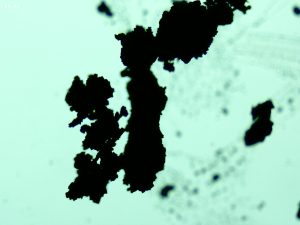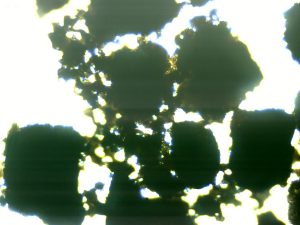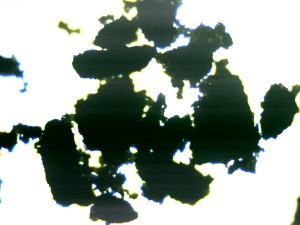Some time ago — in a post on 20-Dec-2013 — I mentioned trouble with a custom ground coffee, from a specialty coffee shop, clogging the espresso machine. I speculated that the difficulty arose from the custom ground coffee having been ground too finely. I’m pleased that the problem with using the specialty store’s coffee has been resolved, and can report my technique for using it. My speculation regarding grind size is not validated however. So, although I have a solution to the problem, how to enjoy the specialty store’s coffee, my hypothesis about grind particle size is not substantiated by what I’ve observed through the microscope.
First, the method: how to use a coffee grind that clogs the machine. The solution is like what one does with gravel to get good drainage. First put down a layer of coarse gravel — store-bought espresso ground coffee, which does not clog the machine. Then put down a layer of the finer gravel — the specialty store’s coffee. Since my espresso making usually involves coffee for two, that means two scoops, and everything works out easily: one scoop from the standard espresso, tamp it a bit, then the second scoop from the specialty espresso, and tamp a bit further, and then brew. It is excellent to be able to use this great-tasting specialty espresso in my machine.
Now, some microphotographs of the specialty coffee, and of three different standard espresso grinds. These are very crude, as I’m not a good microphotographer. Back lighting in each case. Each of the three standard espressos is a different brand of espresso from the grocery store.
The specialty coffee — the particles look a bit elongated:
And the three grocery store espresso coffees:
Each of the latter three appears to have particles which are uniform in width. So it may be that the difference is not the particle overall dimensions — related to the grinder setting — but rather to the specialty store’s grinder producing long thin particles. Those then could stick end-wise into the filter of the espresso machine.
Whatever. I’m just happy to be able to use the specialty store’s coffee, in a 50-50 mix with grocery coffee.
Best wishes,
Ken Roberts
19-Apr-2014


